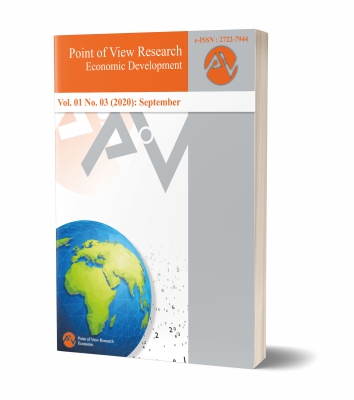Factors Affecting The Export of Coffee In South Sulawesi Province
Abstract
This study aims to determine the factors that affect the volume of coffee exports in South Sulawesi. The independent variables contained in this study are coffee production, exchange rates, and prices. In comparison, the dependent variable in this study is the volume of exports. The type of research used in this study is time-series data during the 2000-2018 period. The data analysis in this study used the classical assumption test (normality test (Kolmogorov-Smirnov test), auto-correction test (Durbin Watson Test) Multicoinirietas test), Descriptive Analysis, and Multiple Regression Analysis. On the results of the Partial Test (T-test) Variable. Production, exchange rates, and prices have a positive and significant impact on the export volume of coffee. In the simultaneous test results (Test F), the production variables, exchange rates, and prices simultaneously positively and significantly affect coffee exports.
Downloads
References
Afidchao, M. M., Musters, C. J. M., Wossink, A., Balderama, O. F., & De Snoo, G. R. (2014). Analysing the farm level economic impact of GM corn in the Philippines. NJAS - Wageningen Journal of Life Sciences, 70, 113–121. https://doi.org/10.1016/j.njas.2014.05.008
Agriculture and Agri-Food Canada. (2014). Foodservice Profile Indonesia. Global Analysis Report, July, 1–11. https://doi.org/Agriculture And Agri-Food Canada
Arfah, A., Olilingo, F. Z., Syaifuddin, S., Dahliah, D., Nurmiati, N., & Putra, A. H. P. K. (2020). Economics During Global Recession: Sharia-Economics as a Post COVID-19 Agenda. The Journal of Asian Finance, Economics and Business, 7(11), 1077–1085.
Candemir, A., & Zalluhoglu, A. E. (2011). The effect of marketing expenditures during financial crisis: The case of Turkey. Procedia - Social and Behavioral Sciences, 24, 291–299. https://doi.org/10.1016/j.sbspro.2011.09.105
Dahliah, D., Kurniawan, A., & Putra, A. H. P. K. (2020). Analysis and Strategy of Economic Development Policy for SMEs in Indonesia. The Journal of Asian Finance, Economics and Business, 7(5), 103–110.
Devereux, M. B., & Yu, C. (2019). Evaluating the role of capital controls and monetary policy in emerging market crises. Journal of International Money and Finance, 95, 189–211. https://doi.org/10.1016/j.jimonfin.2018.06.009
Efrat, K., Hughes, P., Nemkova, E., Souchon, A. L., & Sy-Changco, J. (2018). Leveraging of Dynamic export capabilities for competitive advantage and performance consequences: Evidence from China. Journal of Business Research, 84(August 2017), 114–124. https://doi.org/10.1016/j.jbusres.2017.11.018
Fagerberg, J. (1988). International Competitiveness. Economic Journal, 98(391), 355–374. http://www.jstor.org/stable/223337.
Field, A., Miles, J., & Field, Z. (2013). Discovering Statistics Using SPSS. In Sage (Vol. 81, Issue 1). https://doi.org/10.1111/insr.12011_21
Fizaine, F., & Court, V. (2016). Energy expenditure, economic growth, and the minimum EROI of society. Energy Policy, 95, 172–186. https://doi.org/10.1016/j.enpol.2016.04.039
Hendrayati, H., & Gaffar, V. (2016). Innovation and Marketing Performance of Womenpreneur in Fashion Industry in Indonesia. Procedia - Social and Behavioral Sciences, 219, 299–306. https://doi.org/10.1016/j.sbspro.2016.04.034
Khan, S. M., & Khan, Z. S. (2007). World Investment Report 2006, FDI from Developing and Transition Economies: Implications for Development by United Nations Conference on Trade and Development (UNCTAD). United Nations Publications, New York (2006). Journal of Asian Economics. https://doi.org/10.1016/j.asieco.2007.02.015
Aryati Arfah / Aditya Halim Perdana Kusuma Putra.
Point of View Research Economic Development 1(3) 2020. September. pp 39-50
Laurens, S., & Perdana Kusuma Putra, A. H. (2020). Poverty alleviation efforts through MDG’s and economic resources in Indonesia. Journal of Asian Finance, Economics and Business, 7(9). https://doi.org/10.13106/JAFEB.2020.VOL7.NO9.755
Lukman, A. F., Adebimpe, O., Onate, C. A., Ogundokun, R. O., Gbadamosi, B., & O. Oluwayemi, M. (2018). Data on expenditure, revenue, and economic growth in Nigeria. Data in Brief, 20, 1704–1709. https://doi.org/10.1016/j.dib.2018.08.191
Narayan, P. K., Devpura, N., & Wang, H. (2020). Japanese currency and stock market—What happened during the COVID-19 pandemic? Economic Analysis and Policy, 68, 191–198. https://doi.org/10.1016/j.eap.2020.09.014
Nguyen, H. H. (2019). The Role of State Budget Expenditure on Economic Growth: Empirical Study in Vietnam. The Journal of Asian Finance, Economics and Business, 6(3), 81–89.
Nguyen, H. T. H., & Doan, T. N. (2017). The ASEAN Free Trade Agreement and Vietnam’s Trade Efficiency. Asian Social Science, 13(4), 192. https://doi.org/10.5539/ass.v13n4p192
Oktora, S. I., & Firdani, A. M. (2019). Natural Rubber Economics between China and Southeast Asia: The Impact of China’s Economic Slowdown. The Journal of Asian Finance, Economics and Business, 6(2), 55–62.
Olilingo, F. Z., & Putra, A. H. P. K. (2020). How Indonesia Economics Works: Correlation Analysis of Macroeconomics in 2010-2019. Journal Asian Finance Economic and Business, 7(8), 117–130.
Piveteau, P., & Smagghue, G. (2019). Estimating firm product quality using trade data. Journal of International Economics, 118, 217–232. https://doi.org/https://doi.org/10.1016/j.jinteco.2019.02.005
Soto, R. (2009). Dollarization, economic growth, and employment. Economics Letters, 105(1), 42–45. https://doi.org/10.1016/j.econlet.2009.05.012
Sukirno, S. (2003). Pengantar Teori Mikroekonomi. In Computer. https://doi.org/10.1038/cddis.2011.1
Sukirno, S. (2004). Makroekonomi teori pengantar. Jakarta: PT Raja Grafindo Persada.
Sunderlin, W. D., Resosudarmo, I. A. P., Rianto, E., & Angelsen, A. (2000). The Effect of Indonesia’ s Economic Crisis
on Small Farmers and Natural Forest Cover in the Outer Islands. CIFOR Occasional Paper.
Warr, P. (2005). Food policy and poverty in Indonesia: a general equilibrium analysis. Australian Journal of Agricultural and Resource Economics, 49(4), 429–451.
Yusof, R. (2007). Stock Market Volatility Transmission in Malaysia: Islamic Versus Conventional Stock Market. Journal of King Abdulaziz University-Islamic Economics. https://doi.org/10.4197/islec.20-2.2
Copyright (c) 2020 Aryati Arfah, Aditya Halim Perdana Kusuma Putra

This work is licensed under a Creative Commons Attribution 4.0 International License.



















